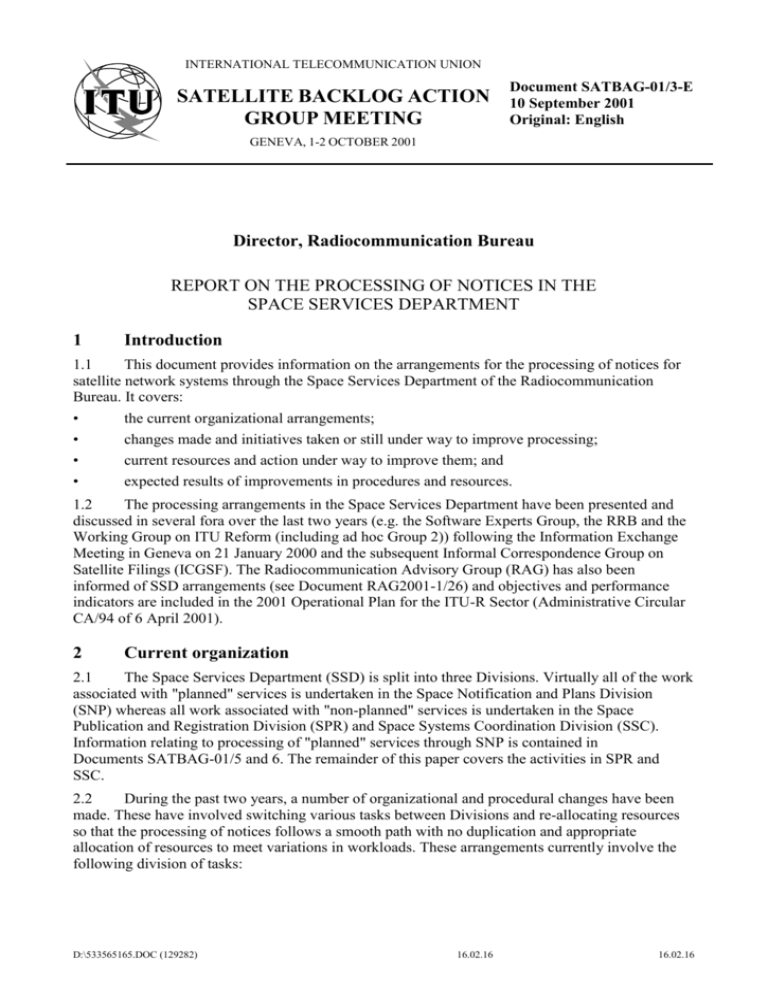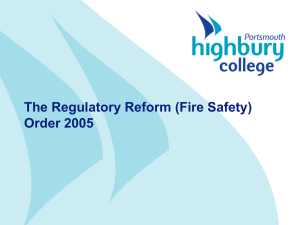1 Introduction
advertisement

INTERNATIONAL TELECOMMUNICATION UNION SATELLITE BACKLOG ACTION GROUP MEETING Document SATBAG-01/3-E 10 September 2001 Original: English GENEVA, 1-2 OCTOBER 2001 Director, Radiocommunication Bureau REPORT ON THE PROCESSING OF NOTICES IN THE SPACE SERVICES DEPARTMENT 1 Introduction 1.1 This document provides information on the arrangements for the processing of notices for satellite network systems through the Space Services Department of the Radiocommunication Bureau. It covers: • the current organizational arrangements; • changes made and initiatives taken or still under way to improve processing; • current resources and action under way to improve them; and • expected results of improvements in procedures and resources. 1.2 The processing arrangements in the Space Services Department have been presented and discussed in several fora over the last two years (e.g. the Software Experts Group, the RRB and the Working Group on ITU Reform (including ad hoc Group 2)) following the Information Exchange Meeting in Geneva on 21 January 2000 and the subsequent Informal Correspondence Group on Satellite Filings (ICGSF). The Radiocommunication Advisory Group (RAG) has also been informed of SSD arrangements (see Document RAG2001-1/26) and objectives and performance indicators are included in the 2001 Operational Plan for the ITU-R Sector (Administrative Circular CA/94 of 6 April 2001). 2 Current organization 2.1 The Space Services Department (SSD) is split into three Divisions. Virtually all of the work associated with "planned" services is undertaken in the Space Notification and Plans Division (SNP) whereas all work associated with "non-planned" services is undertaken in the Space Publication and Registration Division (SPR) and Space Systems Coordination Division (SSC). Information relating to processing of "planned" services through SNP is contained in Documents SATBAG-01/5 and 6. The remainder of this paper covers the activities in SPR and SSC. 2.2 During the past two years, a number of organizational and procedural changes have been made. These have involved switching various tasks between Divisions and re-allocating resources so that the processing of notices follows a smooth path with no duplication and appropriate allocation of resources to meet variations in workloads. These arrangements currently involve the following division of tasks: D:\533565165.DOC (129282) 16.02.16 16.02.16 -2SATBAG-01/3-E 2.2.1 staff: • • • • • • • • • • • Space Publication and Registration Division (SPR) - six professional and 25 general service 2.2.2 staff: • Space Systems Coordination Division (SSC) - 11 professional and five general service Receipt and capture (all notices) Graphics processing and capture Validation (coordination and notification) Publication "as received" Advance Publication Information (APIs) - receipt, capture, validation and publication Database management (SNS and SNL) Findings capture and publication (BRIFIC) Cost recovery File management/archives WRCs preparation/support Software specification development. • • • • • • Regulatory and technical examination of coordination and notification cases (e.g. S9.35 and S11.31) including associated procedures (e.g. S9.53A progress report, regulatory reminders) Checking and management of regulatory time limits (S9.5D , S11.44.1 and S11.48) Due diligence (Resolution 49) Assistance to administrations (e.g. S9.46, S9.60) Development/modifications to Rules of Procedure WRCs preparation/support Software specification development. 3 Work status 3.1 Notwithstanding the continuing heavy influx of coordination requests and notifications and the continuing backlog, there have been a number of improvements made in the status of the processing of notices for "non-planned" services through SSD. 3.2 In SPR, all notices are received electronically although graphics information is still received in paper form. All previous "paper" notices for coordination requests have now been captured and the last remaining paper notices for notification (70 cases) should be captured within the next three months. All notices in the backlog were scanned and published "as received" in the BRIFIC from early in 2000 and, since July 2000, have continued to be published "as received" pursuant to Resolution 55 (WRC-2000). 3.3 Virtually all processes in SPR are now automated with the exception of receipt of graphics information. A substantial amount of resources is devoted to the validation and restructuring of notices (e.g. splitting frequency groups) prior to technical examination. Whilst notices are received electronically, this has not improved the quality of their content. This results in extensive examination time and frequent correspondence with administrations. Validation efforts should be reduced substantially after 1 January 2002, when all notices (coordination and notification) will not be recorded as received until all mandatory APS4 information has been provided (in accordance with the Rules of Procedure on "receivability"). Such "completeness" will be checked with the D:\533565165.DOC (129282) 16.02.16 16.02.16 -3SATBAG-01/3-E validation software. As at 4 September 2001 there are 877 coordination request notices in various stages of validation and 441 completed and awaiting technical/regulatory examination in SSC. There is virtually no backlog in notices awaiting publication (following technical/regulatory examination). For notification, there are 179 space station and 438 earth station notices in various stages of validation. There is virtually no backlog in validated and cleared notification cases awaiting examination in SSC. 3.4 In SSC, a number of the elements of the technical examination for both coordination and notification procedures are almost fully automated (e.g. software for PFD and coordination requirements - delta T/T and coordination arc procedures are available and are progressing to greater automated integration into the examination process). Some regulatory examination is still manual but some work is under way internally towards developing software and automated procedures to improve this situation, in relation particularly to Article S5, and the work currently under way in Working Party 4A should also assist in this regard. A framework for automating notification examination processes is also being developed. 3.5 As noted in the 2001 Operational Plan for the ITU-R, the average rate of publication of coordination requests in 2000 was 27 special sections per month. An improved rate of processing of up to 40 per month was projected for 2001 (assuming availability of resources of an average of 42 professional staff months). The average rate of publication so far in 2001 (up to end-July 2001) has been 52 special sections per month. These rates of processing have been improved despite a somewhat lower level of staff resources currently available and a significant volume of cases (about 800 networks) examined, and soon to be published, under resolves 5 of Resolution 533 (Rev.WRC-2000). 3.6 Processing of due diligence (Resolution 49 (Rev.WRC-2000)) is proceeding in line with the objectives in the 2001 Operational Plan. However, as noted in Document SATBAG-01/1, the results of these processes are considered to be negligible in terms of the backlog. Some four professional staff months and four general service staff months are involved in processing due diligence. Processing of assistance cases are also proceeding as estimated in the Operational Plan. 3.7 For notification cases, the number of cases treated as at end July 2001 has been 73 space stations and 109 earth stations which is similar, at this stage, to the rate anticipated in the Operational Plan. 4 Resources 4.1 As previously noted in Document RAG2001-1/26, and in the information above, the main point at which the backlog is building up is in awaiting the technical and regulatory examination for coordination requests in SSC. On an assumption of further improvement in validation of notices in SPR, two P1 professional staff posts have been transferred to SSC, (one filled, one vacant). In addition, recruitment steps are under way for a number of professional staff posts that will be used primarily for technical/regulatory examination in SSC. At the P1 level, two recommended appointees are currently being processed through the Personnel Department for posts in SSC and SPR. Applications are also being currently considered with an objective of filling a further five professional staff posts (two P3, three P4) in SSC . Appointments to these posts are expected to be made within one month and should be available before the end of 2001. These new appointments will result in an increase from the current four professional staff working on the examination of coordination requests to nine (this includes filling one post previously devoted to notification). D:\533565165.DOC (129282) 16.02.16 16.02.16 -4SATBAG-01/3-E 4.2 As noted previously, the ITU recruitment process is relatively long. There is also a need for staff to build-up "on-the-job" experience in performing space network coordination examinations. It is desirable for there to be a high level of stability in staff tenure and training to achieve optimum productivity in this field of activity. 4.3 Based on current rates of processing of coordination requests and the addition of the above-mentioned resources, it could be anticipated that the rate of performance and reduction in the backlog could be as noted in the graph in Annex 1. These simulations are based on current processes (additional professional staff available on 1 January 2002, one-year learning process "on-the-job") and do not take any account of further improvements through automation or through any changes of procedures as a result of the initiatives in Council Resolution 1182. Annex: 1 D:\533565165.DOC (129282) 16.02.16 16.02.16 -5SATBAG-01/3-E ANNEX 1 2000.00 Months Coordination Requests 35 34.5 31 1800.00 30 Backlog (network) (500 CR / year) 1600.00 26 1465.72 25 1400.00 Treatment delay (month) (400 CR / year) 1365.72 Treatment delay (month) (500 CR / year) 1200.00 20 CR date of receipt = 22.05.98 1087.32 1000.00 Backlog (network) (400 CR / year) 15 887.32 800.00 600.00 10 Planned Reduction in the Coordination Request Backlog 400.00 CR date of receipt = 15.02.03 5 200.00 CR date of receipt = 15.11.03 0.00 0 1 / 0 1 D:\533565165.DOC (129282) 4 / 0 1 7 / 0 1 1 0 / 0 1 1 / 0 2 4 / 0 2 16.02.16 7 / 0 2 1 0 / 0 2 1 / 0 3 4 / 0 3 16.02.16 7 / 0 3 1 0 / 0 3 1 / 0 4






